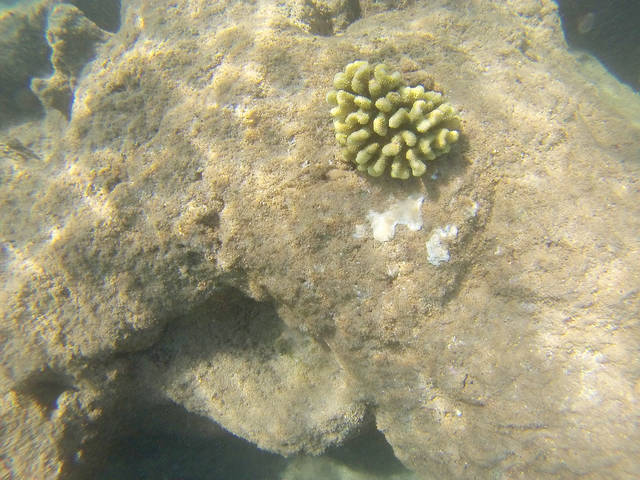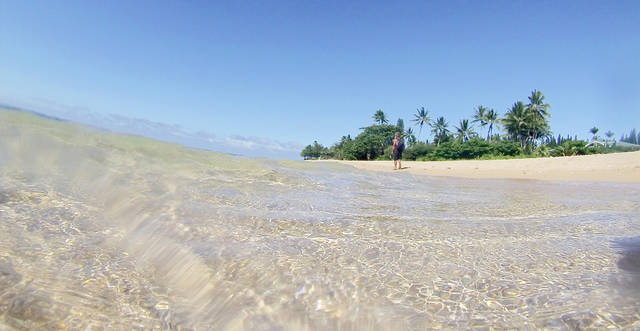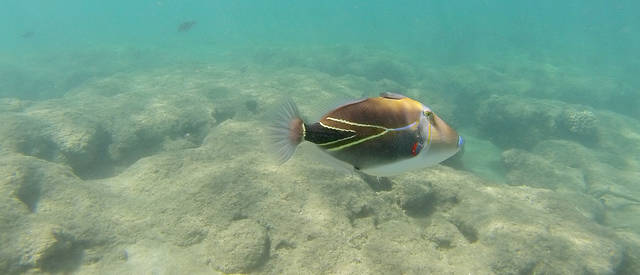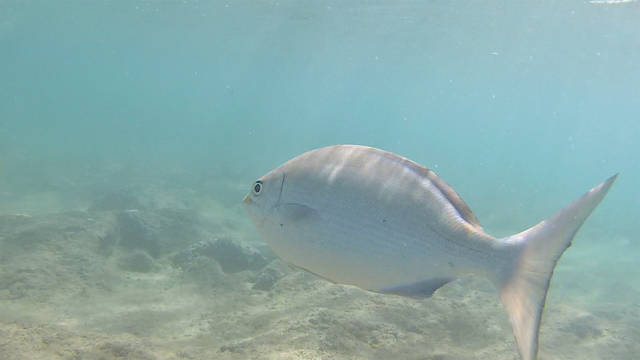HAENA — Four months after the April flood that put the North Shore off-limits to visitors and most others, there was talk of a rejuvenation of marine life. More coral and more fish, thanks to there being almost no people in the water.
Without the constant streams of tourists venturing out to snorkel and play and to hike the Kalalau, there was talk of a quieter, more peaceful, most serene lifestyle again. A return to the good ole’ days.
Some of that proved to be true on a recent trip to Tunnels Beach (Makua) on a sunny Saturday afternoon. Some didn’t.
Once you’ve passed the checkpoint and the convoy leads you and others through the construction zone, you’re on your own.
On the drive to Tunnels, I saw just a few people, one being a boy riding his bike down the road, seeming to be unaware of a vehicle coming up behind him. A man was out mowing his lawn.
It is strange, as you drive along, passing abandoned, rusted cars still on the roadside. It is strange having no traffic coming the opposite way. Even the houses appeared to be without signs of life. The Wainiha store was closed.
I parked at Haena Beach Park. There were a few tents and cars. One bearded man standing alone greeted me.
“Aloha,” he said.
Tunnels Beach was its usual beautiful self. Blue waters, waves, sunshine. A few people on the beach every 50 or 100 yards, lounging, tanning, reading. A woman played with two children in the water, but otherwise, no one was out there.
After I had walked perhaps a quarter mile or so, I picked out a spot and stopped. Seemed open. A few hundred yards from shore, there were two boats with what appeared to be a snorkeling party, as I could see heads appearing from below and then disappearing.
It had been more than a year since I had visited Tunnels and I had high hopes to see a rebirth of coral and schools of colorful fish swarming around. Such a rebirth had been reported on at Anini Beach in The Garden Island earlier in the year. Yellow antler corals, pink cauliflower corals, and purple lobe corals were all healthy in the area in March, and researchers say they’ve seen up to eight inches of coral growth there.
As I snorkeled into deeper water, where the reefs end and all is lost into a blue abyss, I saw a few patches of cauliflower coral. I spent about an hour heading out and along the shoreline. I saw what looked like a thin layer of mud and sediment covering reefs and the little coral there was.
Fish came by, alone, and in larger numbers, some colorful, large and apparently quite used to people. A nenue seemed to pose for a picture. Kala came and went. A triggerfish circled me, which I found unnerving. Bluespine unicornfish paid me no mind.
The fish population did not seem to be any more than what I had seen on previous visits. There weren’t the swarms in the shallows I had heard reports of. Yet, this was only one day, one visit. Still, the marine life wasn’t what I had hoped to see. But that rejuvenation I had heard about may be in another area of Tunnels. Perhaps, out deeper, where the boats and snorkelers floated there were more fish and more coral. Alone, though, and with few around who might even notice me, I was afraid of swimming out too far to find out.
I asked my friend and marine biologist Terry Lilley, who dives the area more than anyone I know, if he had seen the rebirth at Tunnels.
No, he answered. He said he has dove at Tunnels a number of times and seen fewer fish than before the flood.
“The corals are doing terrible, too,” he said. “I think the coating of mud on the reef just has not washed away yet due to the lack of surf.”
The sediment and the mud keep the coral from growing and thus, the fish move on to other sites for food.
He added that some folks are noticing the fish in Haena because they are coming close to shore due to the lack of tourists but said a real survey would need to be done to determine if the actual fish population has increased or decreased at each location or has just moved around.
Lilley hopes to get funding to do reef check surveys.
“This is a golden opportunity to document the reefs and marine life without tourists to see how it may change with tourists,” he said. “This may help us better manage our reefs in the future.”






I remember as a young boy while travelling through those little northern communities (Hanalei to Haena) with my mom and dad in an old army jeep(that was the only vehicle we had then). It was so quiet and peaceful drive through. it was so quiet that one could hear a pin drop.
Mom and dad would tell us (my 3sisters and myself) to be very quiet and use our soft voice.
I haven’t been down that end for many years. I can only imagine without the traffic , “how quiet and peaceful it is !” Finally the locals in that area can enjoy the quietness.
Hopefully the ocean and beaches recover quickly!
Aloha Bill – most people on the north shore know Tery Lilley isn’t a marine biologist, even though he claims to be one. Please do your research and look for more reputable sources, like UH’s Institute of Marine biology or DAR.
Not unexpected. The ban on suntan lotion has not taken effect, and this article clearly states there are still people on the beach. Round up is still in use too and washing into our pristine envirnment.
This is an article that has no basis in fact. Corals can die overnight, but take years to recover. I keep coral reefs for a hobby and I have vast knowledge and experience in this area. It has been five months since the road was closed, there is no way a population increase of fish due to replication has occurred. If you go down south to The Beach House restaurant, many times there are more fish and a greater variety of fish in that little beach than in Tunnels or Ke’e. Fish move around their territory for many reasons, such as brown water, lack of food, abundance of food etc. To say there are more fish and corals because of less tourists is laughable.
i had also expected to see livelier reefs, with more fish and vibrant coral grown, but it is the same as it was before. Perhaps the Norman & Olivia swells will help to flush the sediment from the reefs.